Comprehensive Enhancement of Prepolymer-Based Flexible Polyurethane Foams’ Performance by Introduction of Cost-Effective Waste-Based Ground Tire Rubber Particles
Abstract
:1. Introduction
2. Materials and Methods
2.1. Materials
2.2. Preparation of Flexible Polyurethane Foams
2.3. Measurements
- total color difference parameter (ΔE*), calculated according to the Equation (1) [55]:
- chroma (C*ab), calculated according to the Equation (2):
- hue (hab), calculated according to the Equation (3):
3. Results and Discussion
4. Conclusions
Author Contributions
Funding
Institutional Review Board Statement
Informed Consent Statement
Data Availability Statement
Conflicts of Interest
References
- Hejna, A.; Kopczyńska, M.; Kozłowska, U.; Klein, M.; Kosmela, P.; Piszczyk, Ł. Foamed Polyurethane Composites with Different Types of Ash-Morphological, Mechanical and Thermal Behavior Assessments. Cell. Polym. 2016, 35, 287–308. [Google Scholar] [CrossRef]
- Bukowczan, A.; Hebda, E.; Michałowski, S.; Pielichowski, K. Modification of Polyurethane Viscoelastic Foams by Functionalized Polyhedral Oligomeric Silsesquioxanes (POSS). Compos. Theory Pract. 2018, 18, 77–81. [Google Scholar]
- Fei, Y.; Chen, F.; Fang, W.; Hejna, A.; Xu, L.; Liu, T.; Zhong, M.; Yang, J.; Kuang, T. Conductive Thermoplastic Polyurethane Nanocomposite Foams Derived from a Cellulose/MWCNTs Aerogel Framework: Simultaneous Enhancement of Piezoresistance, Strength, and Endurance. J. Mater. Chem. C 2021, 9, 13103–13114. [Google Scholar] [CrossRef]
- Das, A.; Mahanwar, P. A Brief Discussion on Advances in Polyurethane Applications. Adv. Ind. Eng. Polym. Res. 2020, 3, 93–101. [Google Scholar] [CrossRef]
- Sawpan, M.A. Polyurethanes from Vegetable Oils and Applications: A Review. J. Polym. Res. 2018, 25, 184. [Google Scholar] [CrossRef]
- Petrovic, Z. Polyurethanes from Vegetable Oils. Polym. Rev. 2008, 48, 109–155. [Google Scholar] [CrossRef]
- Desroches, M.; Escouvois, M.; Auvergne, R.; Caillol, S.; Boutevin, B. From Vegetable Oils to Polyurethanes: Synthetic Routes to Polyols and Main Industrial Products. Polym. Rev. 2012, 52, 38–79. [Google Scholar] [CrossRef]
- Marcovich, N.E.; Kurańska, M.; Prociak, A.; Malewska, E.; Kulpa, K. Open Cell Semi-Rigid Polyurethane Foams Synthesized Using Palm Oil-Based Bio-Polyol. Ind. Crops Prod. 2017, 102, 88–96. [Google Scholar] [CrossRef]
- Feng, Y.; Liang, H.; Yang, Z.; Yuan, T.; Luo, Y.; Li, P.; Yang, Z.; Zhang, C. A Solvent-Free and Scalable Method to Prepare Soybean-Oil-Based Polyols by Thiol–Ene Photo-Click Reaction and Biobased Polyurethanes Therefrom. ACS Sustain. Chem. Eng. 2017, 5, 7365–7373. [Google Scholar] [CrossRef]
- Chu, M.M.; Maguire, G. Global Edible Oil Prices near Their Peak, but Retreat May Be Slow—Analysts. Available online: https://www.reuters.com/article/us-global-palmoil-prices-analysts-idUSKBN2BG2CJ2021 (accessed on 20 July 2022).
- George, B. Oilseeds: World Markets and Trade; Foreign Agricultural Service, U.S. Department of Agriculture: Washington, DC, USA, 12 August 2022. Available online: https://www.fas.usda.gov/data/oilseeds-world-markets-and-trade (accessed on 20 July 2022).
- Fridrihsone, A.; Abolins, A.; Kirpluks, M. Screening Life Cycle Assessment of Tall Oil-Based Polyols Suitable for Rigid Polyurethane Foams. Energies 2020, 13, 5249. [Google Scholar] [CrossRef]
- Fridrihsone, A.; Romagnoli, F.; Kirsanovs, V.; Cabulis, U. Life Cycle Assessment of Vegetable Oil Based Polyols for Polyurethane Production. J. Clean. Prod. 2020, 266, 121403. [Google Scholar] [CrossRef]
- Hejna, A.; Kosmela, P.; Klein, M.; Formela, K.; Kopczyńska, M.; Haponiuk, J.; Piszczyk, Ł. Two-Step Conversion of Crude Glycerol Generated by Biodiesel Production into Biopolyols: Synthesis, Structural and Physical Chemical Characterization. J. Polym. Environ. 2018, 26, 3334–3344. [Google Scholar] [CrossRef]
- Członka, S.; Bertino, M.F.; Strzelec, K.; Strąkowska, A.; Masłowski, M. Rigid Polyurethane Foams Reinforced with Solid Waste Generated in Leather Industry. Polym. Test. 2018, 69, 225–237. [Google Scholar] [CrossRef]
- Augaitis, N.; Vaitkus, S.; Członka, S.; Kairytė, A. Research of Wood Waste as a Potential Filler for Loose-Fill Building Insulation: Appropriate Selection and Incorporation into Polyurethane Biocomposite Foams. Materials 2020, 13, 5336. [Google Scholar] [CrossRef]
- Kurańska, M.; Barczewski, M.; Uram, K.; Lewandowski, K.; Prociak, A.; Michałowski, S. Basalt Waste Management in the Production of Highly Effective Porous Polyurethane Composites for Thermal Insulating Applications. Polym. Test. 2019, 76, 90–100. [Google Scholar] [CrossRef]
- Kurańska, M.; Leszczyńska, M.; Malewska, E.; Prociak, A.; Ryszkowska, J. Implementation of Circular Economy Principles in the Synthesis of Polyurethane Foams. Polymers 2020, 12, 2068. [Google Scholar] [CrossRef] [PubMed]
- Salasinska, K.; Barczewski, M.; Aniśko, J.; Hejna, A.; Celiński, M. Comparative Study of the Reinforcement Type Effect on the Thermomechanical Properties and Burning of Epoxy-Based Composites. J. Compos. Sci. 2021, 5, 89. [Google Scholar] [CrossRef]
- Matykiewicz, D.; Barczewski, M. On the Impact of Flax Fibers as an Internal Layer on the Properties of Basalt-Epoxy Composites Modified with Silanized Basalt Powder. Compos. Commun. 2020, 20, 100360. [Google Scholar] [CrossRef]
- Otto, G.P.; Moisés, M.P.; Carvalho, G.; Rinaldi, A.W.; Garcia, J.C.; Radovanovic, E.; Fávaro, S.L. Mechanical Properties of a Polyurethane Hybrid Composite with Natural Lignocellulosic Fibers. Compos. Part B Eng. 2017, 110, 459–465. [Google Scholar] [CrossRef]
- Zanoletti, A.; Ciacci, L. The Reuse of Municipal Solid Waste Fly Ash as Flame Retardant Filler: A Preliminary Study. Sustainability 2022, 14, 2038. [Google Scholar] [CrossRef]
- Kusakli, S.; Kocaman, S.; Ceyhan, A.A.; Ahmetli, G. Improving the Flame Retardancy and Mechanical Properties of Epoxy Composites Using Flame Retardants with Red Mud Waste. J. Appl. Polym. Sci. 2021, 138, 50106. [Google Scholar] [CrossRef]
- Barczewski, M.; Hejna, A.; Sałasińska, K.; Aniśko, J.; Piasecki, A.; Skórczewska, K.; Andrzejewski, J. Thermomechanical and Fire Properties of Polyethylene-Composite-Filled Ammonium Polyphosphate and Inorganic Fillers: An Evaluation of Their Modification Efficiency. Polymers 2022, 14, 2501. [Google Scholar] [CrossRef]
- Tang, G.; Liu, X.; Zhou, L.; Zhang, P.; Deng, D.; Jiang, H. Steel Slag Waste Combined with Melamine Pyrophosphate as a Flame Retardant for Rigid Polyurethane Foams. Adv. Powder Technol. 2020, 31, 279–286. [Google Scholar] [CrossRef]
- Kuru, D.; Akpinar Borazan, A.; Guru, M. Effect of Chicken Feather and Boron Compounds as Filler on Mechanical and Flame Retardancy Properties of Polymer Composite Materials. Waste Manag. Res. J. Sustain. Circ. Econ. 2018, 36, 1029–1036. [Google Scholar] [CrossRef]
- Salasinska, K.; Celiński, M.; Mizera, K.; Kozikowski, P.; Leszczyński, M.K.; Gajek, A. Synergistic Effect between Histidine Phosphate Complex and Hazelnut Shell for Flammability Reduction of Low-Smoke Emission Epoxy Resin. Polym. Degrad. Stab. 2020, 181, 109292. [Google Scholar] [CrossRef]
- Zabihi, O.; Ahmadi, M.; Yadav, R.; Mahmoodi, R.; Naderi Kalali, E.; Nikafshar, S.; Ghandehari Ferdowsi, M.R.; Wang, D.Y.; Naebe, M. Novel Phosphorous-Based Deep Eutectic Solvents for the Production of Recyclable Macadamia Nutshell–Polymer Biocomposites with Improved Mechanical and Fire Safety Performances. ACS Sustain. Chem. Eng. 2021, 9, 4463–4476. [Google Scholar] [CrossRef]
- Battig, A.; Sanchez-Olivares, G.; Rockel, D.; Maldonado-Santoyo, M.; Schartel, B. Waste not, Want not: The Use of Leather Waste in Flame Retarded EVA. Mater. Des. 2021, 210, 110100. [Google Scholar] [CrossRef]
- Abdulkareem, S.A.; Adeniyi, A.G. Recycling Copper and Polystyrene from Solid Waste Stream in Developing Conductive Composites. J. Solid Waste Technol. Manag. 2019, 45, 39–44. [Google Scholar] [CrossRef]
- Adeniyi, A.G.; Ighalo, J.O.; Abdulkareem, S.A. Al, Fe and Cu Waste Metallic Particles in Conductive Polystyrene Composites. Int. J. Sustain. Eng. 2021, 14, 893–898. [Google Scholar] [CrossRef]
- Kim, W.Y.; Jang, J.; Lee, H.S.; Kim, S.Y. Electrical Conductivity of Polymer Composites Based on Carbonized Wood Flour via Plasma Post-treatment as an Effective and Economical Filler. Polym. Compos. 2021, 42, 4814–4821. [Google Scholar] [CrossRef]
- Giorcelli, M.; Bartoli, M. Development of Coffee Biochar Filler for the Production of Electrical Conductive Reinforced Plastic. Polymers 2019, 11, 1916. [Google Scholar] [CrossRef] [PubMed]
- Gama, N.; Ferreira, A.; Barros-Timmons, A. 3D Printed Thermoplastic Polyurethane Filled with Polyurethane Foams Residues. J. Polym. Environ. 2020, 28, 1560–1570. [Google Scholar] [CrossRef]
- Zhang, L.; Liang, S.; Chen, Z. Influence of Particle Size and Addition of Recycling Phenolic Foam on Mechanical and Flame Retardant Properties of Wood-Phenolic Composites. Constr. Build. Mater. 2018, 168, 1–10. [Google Scholar] [CrossRef]
- Matykiewicz, D.; Sałasińska, K.; Barczewski, M. The Effect of Poly(Vinyl Chloride) Powder Addition on the Thermomechanical Properties of Epoxy Composites Reinforced with Basalt Fiber. Materials 2020, 13, 3611. [Google Scholar] [CrossRef]
- Ratna, D.; Banthia, A.K. Rubber Toughened Epoxy. Macromol. Res. 2004, 12, 11–21. [Google Scholar] [CrossRef]
- Aoudia, K.; Azem, S.; Aït Hocine, N.; Gratton, M.; Pettarin, V.; Seghar, S. Recycling of Waste Tire Rubber: Microwave Devulcanization and Incorporation in a Thermoset Resin. Waste Manag. 2017, 60, 471–481. [Google Scholar] [CrossRef]
- Kandasamy, J.; Gökalp, I. Pyrolysis, Combustion, and Steam Gasification of Various Types of Scrap Tires for Energy Recovery. Energy Fuels 2015, 29, 346–354. [Google Scholar] [CrossRef]
- Formela, K. Sustainable Development of Waste Tires Recycling Technologies—Recent Advances, Challenges and Future Trends. Adv. Ind. Eng. Polym. Res. 2021, 4, 209–222. [Google Scholar] [CrossRef]
- Hejna, A.; Korol, J.; Przybysz-Romatowska, M.; Zedler, Ł.; Chmielnicki, B.; Formela, K. Waste Tire Rubber as Low-Cost and Environmentally-Friendly Modifier in Thermoset Polymers—A Review. Waste Manag. 2020, 108, 106–118. [Google Scholar] [CrossRef]
- Kosmela, P.; Olszewski, A.; Zedler, Ł.; Hejna, A.; Burger, P.; Formela, K. Structural Changes and Their Implications in Foamed Flexible Polyurethane Composites Filled with Rapeseed Oil-Treated Ground Tire Rubber. J. Compos. Sci. 2021, 5, 90. [Google Scholar] [CrossRef]
- Piszczyk, L.; Hejna, A.; Formela, K.; Danowska, M.; Strankowski, M. Rigid Polyurethane Foams Modified with Ground Tire Rubber—Mechanical, Morphological and Thermal Studies. Cell. Polym. 2015, 34, 45–62. [Google Scholar] [CrossRef]
- Piszczyk, Ł.; Hejna, A.; Formela, K.; Danowska, M.; Strankowski, M. Effect of Ground Tire Rubber on Structural, Mechanical and Thermal Properties of Flexible Polyurethane Foams. Iran. Polym. J. 2015, 24, 75–84. [Google Scholar] [CrossRef]
- Piszczyk, L.; Hejna, A.; Danowska, M.; Strankowski, M.; Formela, K. Polyurethane/Ground Tire Rubber Composite Foams Based on Polyglycerol: Processing, Mechanical and Thermal Properties. J. Reinf. Plast. Compos. 2015, 34, 708–717. [Google Scholar] [CrossRef]
- Hejna, A.; Olszewski, A.; Zedler, Ł.; Kosmela, P.; Formela, K. The Impact of Ground Tire Rubber Oxidation with H2O2 and KMnO4 on the Structure and Performance of Flexible Polyurethane/Ground Tire Rubber Composite Foams. Materials 2021, 14, 499. [Google Scholar] [CrossRef]
- Kosmela, P.; Olszewski, A.; Zedler, Ł.; Burger, P.; Piasecki, A.; Formela, K.; Hejna, A. Ground Tire Rubber Filled Flexible Polyurethane Foam—Effect of Waste Rubber Treatment on Composite Performance. Materials 2021, 14, 3807. [Google Scholar] [CrossRef]
- Gayathri, R.; Vasanthakumari, R.; Padmanabhan, C. Thermal and Mechanical Behavior of Polyurethane Foam Modified with Nano Silica, Nano Clay and Crumb Rubber Fillers. Int. J. Sci. Eng. Res. 2013, 4, 301–308. [Google Scholar]
- Zhang, X.; Lu, Z.; Tian, D.; Li, H.; Lu, C. Mechanochemical Devulcanization of Ground Tire Rubber and Its Application in Acoustic Absorbent Polyurethane Foamed Composites. J. Appl. Polym. Sci. 2013, 127, 4006–4014. [Google Scholar] [CrossRef]
- Shan, C.W.; Idris, M.I.; Ghazali, M.I. Study of Flexible Polyurethane Foams Reinforced with Coir Fibres and Tyre Particles. Int. J. Appl. Phys. Math. 2012, 2, 123. [Google Scholar] [CrossRef]
- Tian, Z.; Zhang, Z.; Zhang, K.; Huang, S.; Luo, Y. Preparation and Properties of High Viscosity and Elasticity Asphalt by Styrene–Butadiene–Styrene/Polyurethane Prepolymer Composite Modification. J. Appl. Polym. Sci. 2020, 137, 49123. [Google Scholar] [CrossRef]
- Zedler, Ł.; Kowalkowska-Zedler, D.; Vahabi, H.; Saeb, M.R.; Colom, X.; Cañavate, J.; Wang, S.; Formela, K. Preliminary Investigation on Auto-Thermal Extrusion of Ground Tire Rubber. Materials 2019, 12, 2090. [Google Scholar] [CrossRef]
- Zedler, Ł.; Kowalkowska-Zedler, D.; Colom, X.; Cañavate, J.; Saeb, M.R.; Formela, K. Reactive Sintering of Ground Tire Rubber (GTR) Modified by a Trans-Polyoctenamer Rubber and Curing Additives. Polymers 2020, 12, 3018. [Google Scholar] [CrossRef] [PubMed]
- International Commission on Illumination. CIE Recommendations on Uniform Color Spaces, Color-Difference Equations, and Metric Color Terms. Color Res. Appl. 1977, 2, 5–6. [Google Scholar] [CrossRef]
- Hejna, A.; Marć, M.; Kowalkowska-Zedler, D.; Pladzyk, A.; Barczewski, M. Insights into the Thermo-Mechanical Treatment of Brewers’ Spent Grain as a Potential Filler for Polymer Composites. Polymers 2021, 13, 879. [Google Scholar] [CrossRef]
- Hejna, A.; Barczewski, M.; Skórczewska, K.; Szulc, J.; Chmielnicki, B.; Korol, J.; Formela, K. Sustainable Upcycling of Brewers’ Spent Grain by Thermo-Mechanical Treatment in Twin-Screw Extruder. J. Clean. Prod. 2021, 285, 124839. [Google Scholar] [CrossRef]
- ISO 10534-2; Acoustics-Determination of Sound Absorption Coefficient and Impedance in Impedance Tubes—Part 2: Transfer-Function Method 2003. International Organization for Standardization: Geneva, Switzerland, 2007.
- ASTM E1050-08; Standard Test Method for Impedance and Absorption of Acoustical Material Using a Tube, Two Microphones and a Digital Frequency Analysis System 2008. ASTM International: West Conshohocken, PA, USA, 2008.
- Zedler, Ł.; Kosmela, P.; Olszewski, A.; Burger, P.; Formela, K.; Hejna, A. Recycling of Waste Rubber by Thermo-Mechanical Treatment in a Twin-Screw Extruder. Proceedings 2021, 69, 10. [Google Scholar]
- Rao, R.R.; Mondy, L.A.; Long, K.N.; Celina, M.C.; Wyatt, N.; Roberts, C.C.; Soehnel, M.M.; Brunini, V.E. The Kinetics of Polyurethane Structural Foam Formation: Foaming and Polymerization. AIChE J. 2017, 63, 2945–2957. [Google Scholar] [CrossRef]
- Kosmela, P.; Hejna, A.; Formela, K.; Haponiuk, J.; Piszczyk, Ł. The Study on Application of Biopolyols Obtained by Cellulose Biomass Liquefaction Performed with Crude Glycerol for the Synthesis of Rigid Polyurethane Foams. J. Polym. Environ. 2018, 26, 2546–2554. [Google Scholar] [CrossRef]
- De Sousa, T.P.T.; da Costa, M.S.T.; Guilherme, R.; Orcini, W.; Holgado, L.D.A.; Silveira, E.M.V.; Tavano, O.; Magdalena, A.G.; Catanzaro-Guimarães, S.A.; Kinoshita, A. Polyurethane Derived from Ricinus Communis as Graft for Bone Defect Treatments. Polímeros 2018, 28, 246–255. [Google Scholar] [CrossRef]
- Kosmela, P.; Hejna, A.; Suchorzewski, J.; Piszczyk, Ł.; Haponiuk, J.T. Study on the Structure-Property Dependences of Rigid PUR-PIR Foams Obtained from Marine Biomass-Based Biopolyol. Materials 2020, 13, 1257. [Google Scholar] [CrossRef]
- Hejna, A.; Haponiuk, J.; Piszczyk, Ł.; Klein, M.; Formela, K. Performance Properties of Rigid Polyurethane-Polyisocyanurate/Brewers’ Spent Grain Foamed Composites as Function of Isocyanate Index. e-Polymers 2017, 17, 427–437. [Google Scholar] [CrossRef]
- Faria, P.; Nogueira, T.; Ferreira, A.; Carlos, C.; Rosado, L. AI-Powered Mobile Image Acquisition of Vineyard Insect Traps with Automatic Quality and Adequacy Assessment. Agronomy 2021, 11, 731. [Google Scholar] [CrossRef]
- Hejna, A.; Barczewski, M.; Kosmela, P.; Aniśko, J.; Mysiukiewicz, O.; Marć, M. Mandarin peel as an auspicious functional filler for polymer composites. Maced. J. Chem. Chem. Eng. 2021, 40, 1–18. [Google Scholar] [CrossRef]
- Onur Cinko, U.; Behcet Becerir, B. Dependence of Colour Difference Formulae on Regular Changes of Colour Coordinates in CIELAB Colour Space. Ind. Text. 2019, 70, 248–254. [Google Scholar] [CrossRef]
- Mester, E.; Pecsmány, D.; Jálics, K.; Filep, Á.; Varga, M.; Gráczer, K.; Viskolcz, B.; Fiser, B. Exploring the Potential to Repurpose Flexible Moulded Polyurethane Foams as Acoustic Insulators. Polymers 2021, 14, 163. [Google Scholar] [CrossRef]
- Valipour, F.; Dehghan, S.F.; Hajizadeh, R. The Effect of Nano- and Microfillers on Thermal Properties of Polyurethane Foam. Int. J. Environ. Sci. Technol. 2022, 19, 541–552. [Google Scholar] [CrossRef]
- Piszczyk, Ł.; Hejna, A.; Formela, K.; Danowska, M.; Strankowski, M. Morphology, Mechanical and Thermal Properties of Flexible Polyurethane Foams Modified with Layered Aluminosilicates. Polimery/Polymers 2014, 59, 783–792. [Google Scholar] [CrossRef]
- Stachak, P.; Hebda, E.; Pielichowski, K. Foaming Extrusion of Thermoplastic Polyurethane Modified by POSS Nanofillers. Compos. Theory Pract. 2019, 19, 23–29. [Google Scholar]
- Song, Z.L.; Ma, L.Q.; Wu, Z.J.; He, D.P. Effects of Viscosity on Cellular Structure of Foamed Aluminum in Foaming Process. J. Mater. Sci. 2000, 35, 15–20. [Google Scholar] [CrossRef]
- Sung, G.; Kim, J.H. Influence of Filler Surface Characteristics on Morphological, Physical, Acoustic Properties of Polyurethane Composite Foams Filled with Inorganic Fillers. Compos. Sci. Technol. 2017, 146, 147–154. [Google Scholar] [CrossRef]
- Takashimizu, Y.; Iiyoshi, M. New Parameter of Roundness R: Circularity Corrected by Aspect Ratio. Prog. Earth Planet. Sci. 2016, 3, 2. [Google Scholar] [CrossRef]
- Kurańska, M.; Malewska, E.; Polaczek, K.; Prociak, A.; Kubacka, J. A Pathway toward a New Era of Open-Cell Polyurethane Foams—Influence of Bio-Polyols Derived from Used Cooking Oil on Foams Properties. Materials 2020, 13, 5161. [Google Scholar] [CrossRef] [PubMed]
- Fan, H.; Tekeei, A.; Suppes, G.J.; Hsieh, F.H. Rigid Polyurethane Foams Made from High Viscosity Soy-Polyols. J. Appl. Polym. Sci. 2013, 127, 1623–1629. [Google Scholar] [CrossRef]
- Smoleń, J.; Olszowska, K.; Godzierz, M. Composites of Rigid Polyurethane Foam and Shredded Car Window Glass Particles—Structure and Mechanical Properties. Compos. Theory Pract. 2021, 21, 135–140. [Google Scholar]
- Somdee, P.; Lassú-Kuknyó, T.; Kónya, C.; Szabó, T.; Marossy, K. Thermal Analysis of Polyurethane Elastomers Matrix with Different Chain Extender Contents for Thermal Conductive Application. J. Therm. Anal. Calorim. 2019, 138, 1003–1010. [Google Scholar] [CrossRef]
- Li, R.; Shan, Z. Research on Structural Features and Thermal Conductivity of Waterborne Polyurethane. Prog. Org. Coat. 2017, 104, 271–279. [Google Scholar] [CrossRef]
- Zhang, H.; Fang, W.Z.; Li, Y.M.; Tao, W.Q. Experimental Study of the Thermal Conductivity of Polyurethane Foams. Appl. Therm. Eng. 2017, 115, 528–538. [Google Scholar] [CrossRef]
- Mukhopadhyaya, P.; Kumaran, K.; Normandin, N.; van Reenen, D.; Lackey, J. High-Performance Vacuum Insulation Panel: Development of Alternative Core Materials. J. Cold Reg. Eng. 2008, 22, 103–123. [Google Scholar] [CrossRef]
- Wu, J.W.; Sung, W.F.; Chu, H.S. Thermal Conductivity of Polyurethane Foams. Int. J. Heat Mass Transf. 1999, 42, 2211–2217. [Google Scholar] [CrossRef]
- Kurańska, M.; Prociak, A.; Kirpluks, M.; Cabulis, U. Polyurethane–Polyisocyanurate Foams Modified with Hydroxyl Derivatives of Rapeseed Oil. Ind. Crops Prod. 2015, 74, 849–857. [Google Scholar] [CrossRef]
- Bogdan, M.; Hoerter, J.; Moore, F.O. Meeting the Insulation Requirements of the Building Envelope with Polyurethane and Polyisocyanurate Foam. J. Cell. Plast. 2005, 41, 41–56. [Google Scholar] [CrossRef]
- Benazzouk, A.; Douzane, O.; Mezreb, K.; Laidoudi, B.; Quéneudec, M. Thermal Conductivity of Cement Composites Containing Rubber Waste Particles: Experimental Study and Modelling. Constr. Build. Mater. 2008, 22, 573–579. [Google Scholar] [CrossRef]
- Formela, K.; Hejna, A.; Zedler, Ł.; Przybysz, M.; Ryl, J.; Saeb, M.R.; Piszczyk, Ł. Structural, Thermal and Physico-Mechanical Properties of Polyurethane/Brewers’ Spent Grain Composite Foams Modified with Ground Tire Rubber. Ind. Crops Prod. 2017, 108, 844–852. [Google Scholar] [CrossRef]
- Małysa, T.; Nowacki, K.; Wieczorek, J. Assessment of Sound Absorbing Properties of Polyurethane Sandwich System. Compos. Theory Pract. 2016, 16, 244–248. [Google Scholar]
- Kurańska, M.; Barczewski, R.; Barczewski, M.; Prociak, A.; Polaczek, K. Thermal Insulation and Sound Absorption Properties of Open-Cell Polyurethane Foams Modified with Bio-Polyol Based on Used Cooking Oil. Materials 2020, 13, 5673. [Google Scholar] [CrossRef] [PubMed]
- Zhang, C.; Li, J.; Hu, Z.; Zhu, F.; Huang, Y. Correlation between the Acoustic and Porous Cell Morphology of Polyurethane Foam: Effect of Interconnected Porosity. Mater. Des. 2012, 41, 319–325. [Google Scholar] [CrossRef]
- Abdollahi Baghban, S.; Khorasani, M.; Sadeghi, G.M.M. Soundproofing Flexible Polyurethane Foams: The Impact of Polyester Chemical Structure on the Microphase Separation and Acoustic Damping. J. Appl. Polym. Sci. 2018, 135, 46744. [Google Scholar] [CrossRef]
- Lind-Nordgren, E.; Göransson, P. Optimising Open Porous Foam for Acoustical and Vibrational Performance. J. Sound Vib. 2010, 329, 753–767. [Google Scholar] [CrossRef]
- Gong, W.; Jiang, T.H.; Zeng, X.B.; He, L.; Zhang, C. Experimental-Numerical Studies of the Effect of Cell Structure on the Mechanical Properties of Polypropylene Foams. e-Polymers 2020, 20, 713–723. [Google Scholar] [CrossRef]
- Zhang, R.; Chen, J.; Zhu, Y.; Zhang, J.; Luo, G.; Cao, P.; Shen, Q.; Zhang, L. Correlation Between the Structure and Compressive Property of PMMA Microcellular Foams Fabricated by Supercritical CO2 Foaming Method. Polymers 2020, 12, 315. [Google Scholar] [CrossRef]
- Nadal Gisbert, A.; Crespo Amorós, J.E.; López Martínez, J.; Garcia, A.M. Study of Thermal Degradation Kinetics of Elastomeric Powder (Ground Tire Rubber). Polym.-Plast. Technol. Eng. 2007, 47, 36–39. [Google Scholar] [CrossRef]
- Zedler, Ł.; Przybysz, M.; Klein, M.; Saeb, M.R.; Formela, K. Processing, Physico-Mechanical and Thermal Properties of Reclaimed GTR and NBR/Reclaimed GTR Blends as Function of Various Additives. Polym. Degrad. Stab. 2017, 143, 186–195. [Google Scholar] [CrossRef]
- Formela, K.; Klein, M.; Colom, X.; Saeb, M.R. Investigating the Combined Impact of Plasticizer and Shear Force on the Efficiency of Low Temperature Reclaiming of Ground Tire Rubber (GTR). Polym. Degrad. Stab. 2016, 125, 1–11. [Google Scholar] [CrossRef]
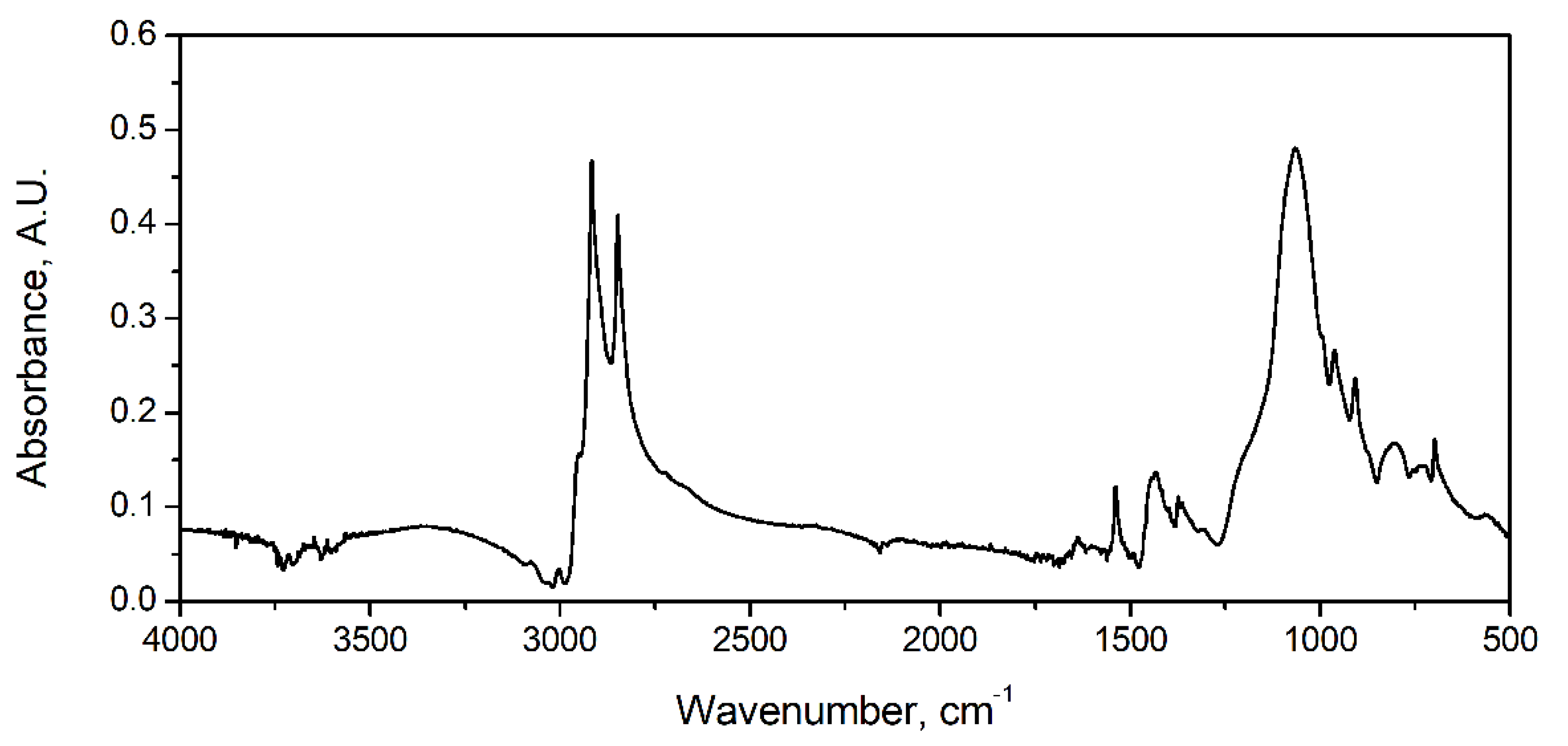

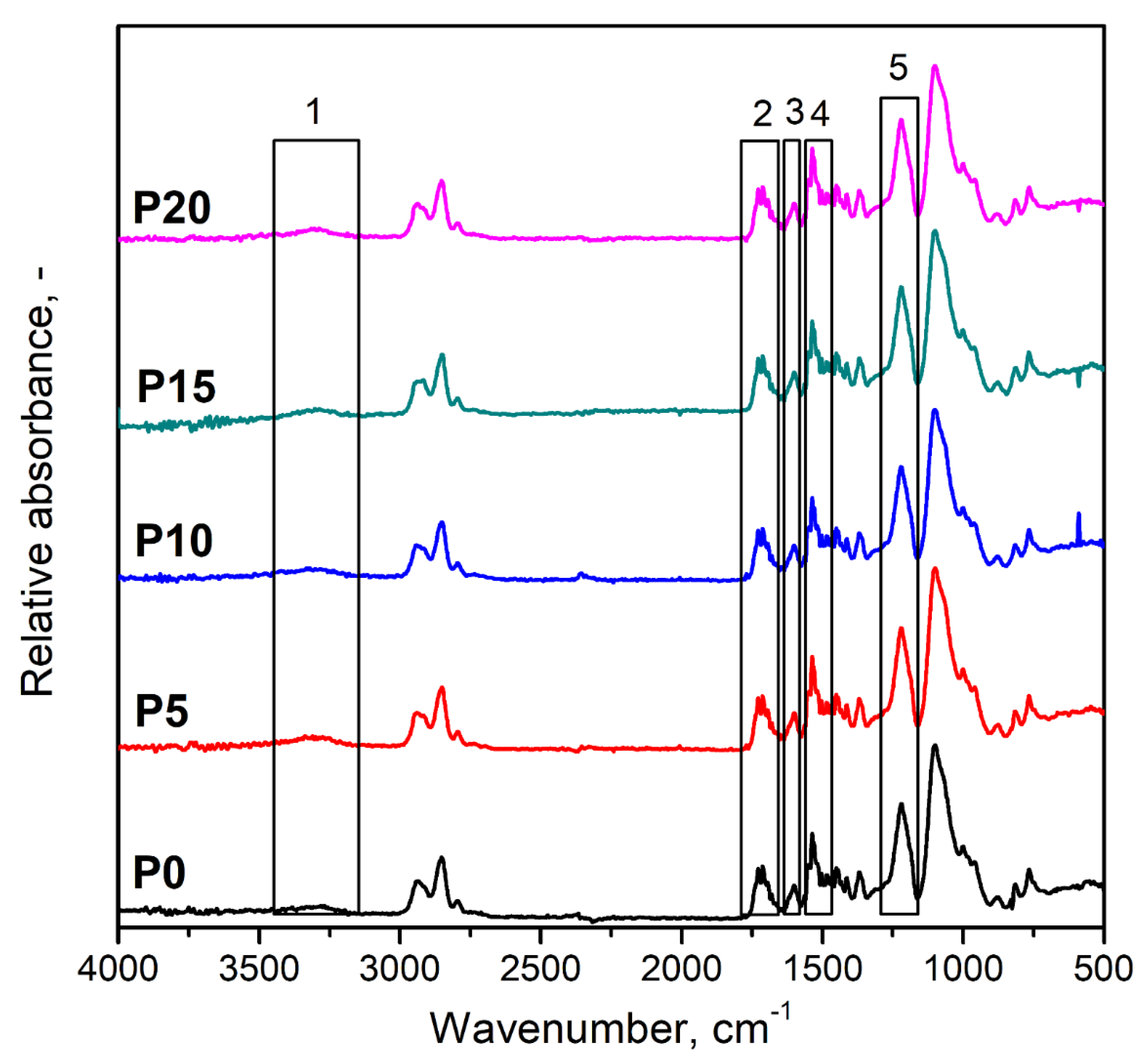

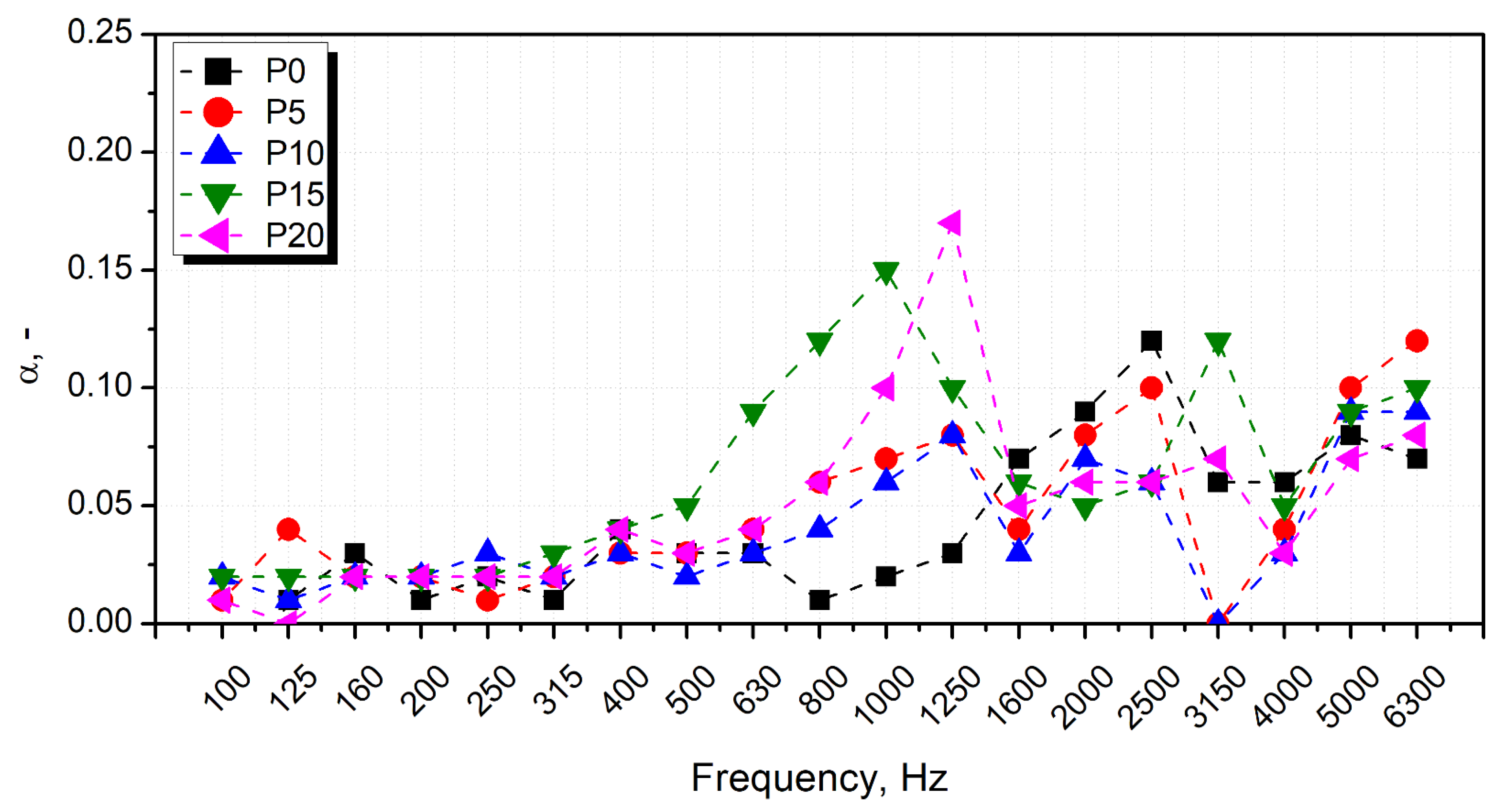
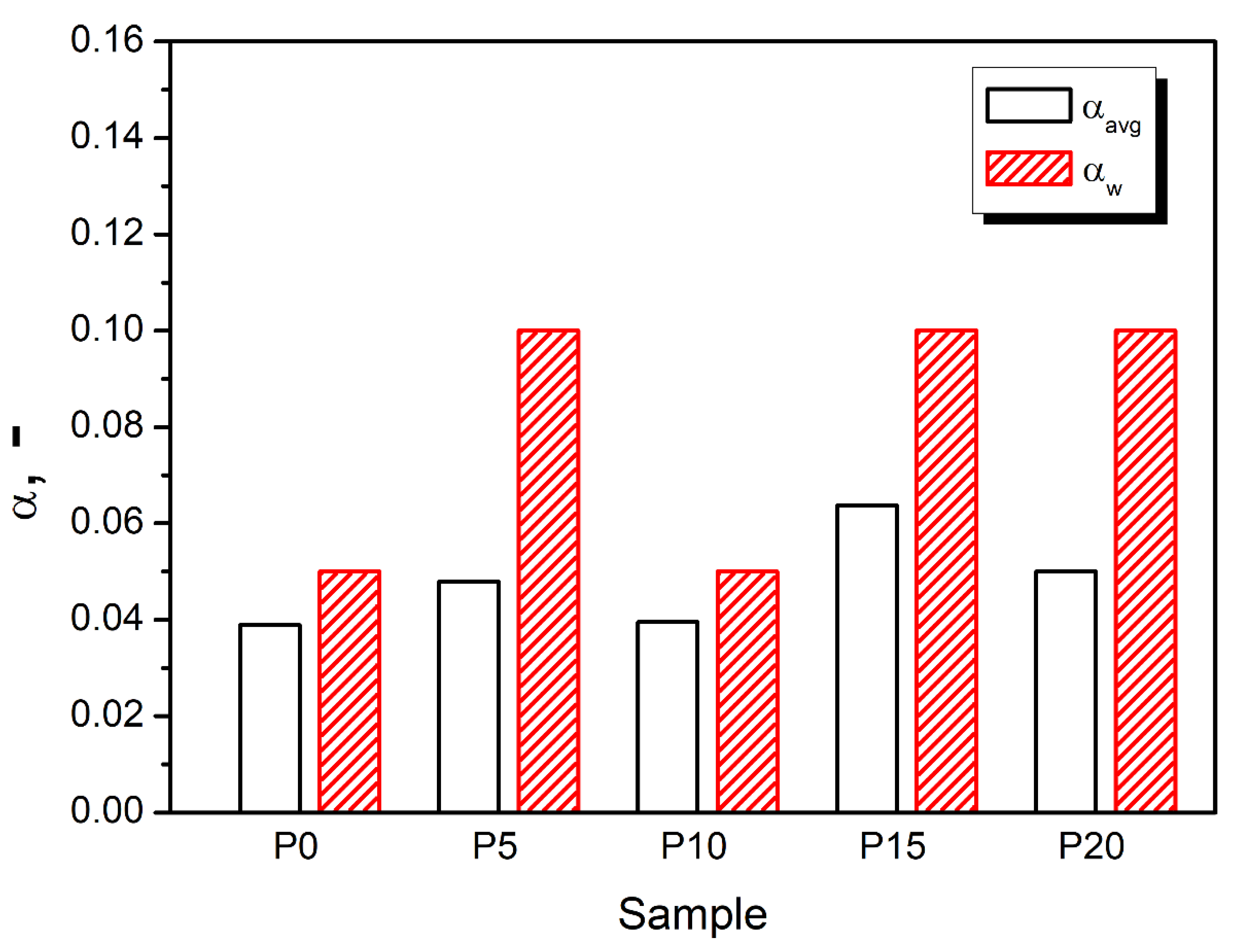
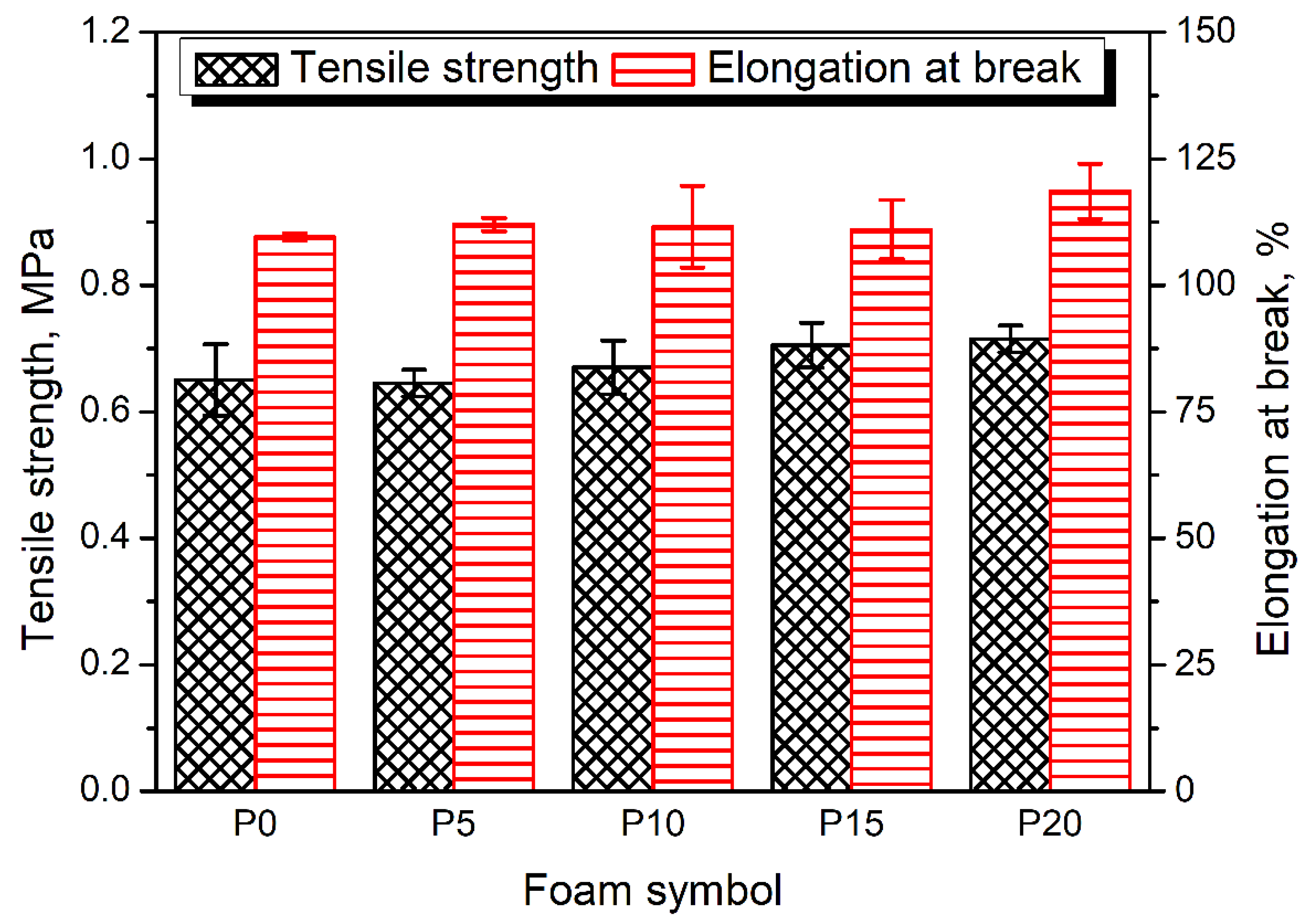
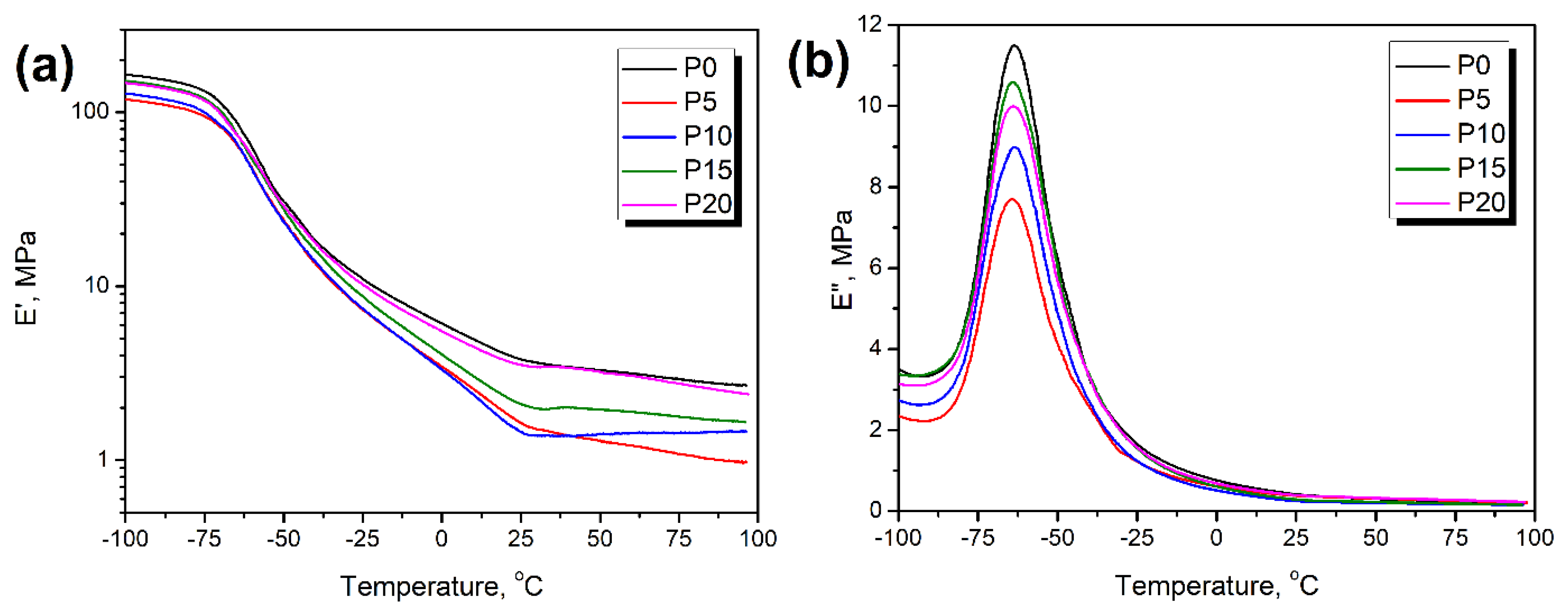
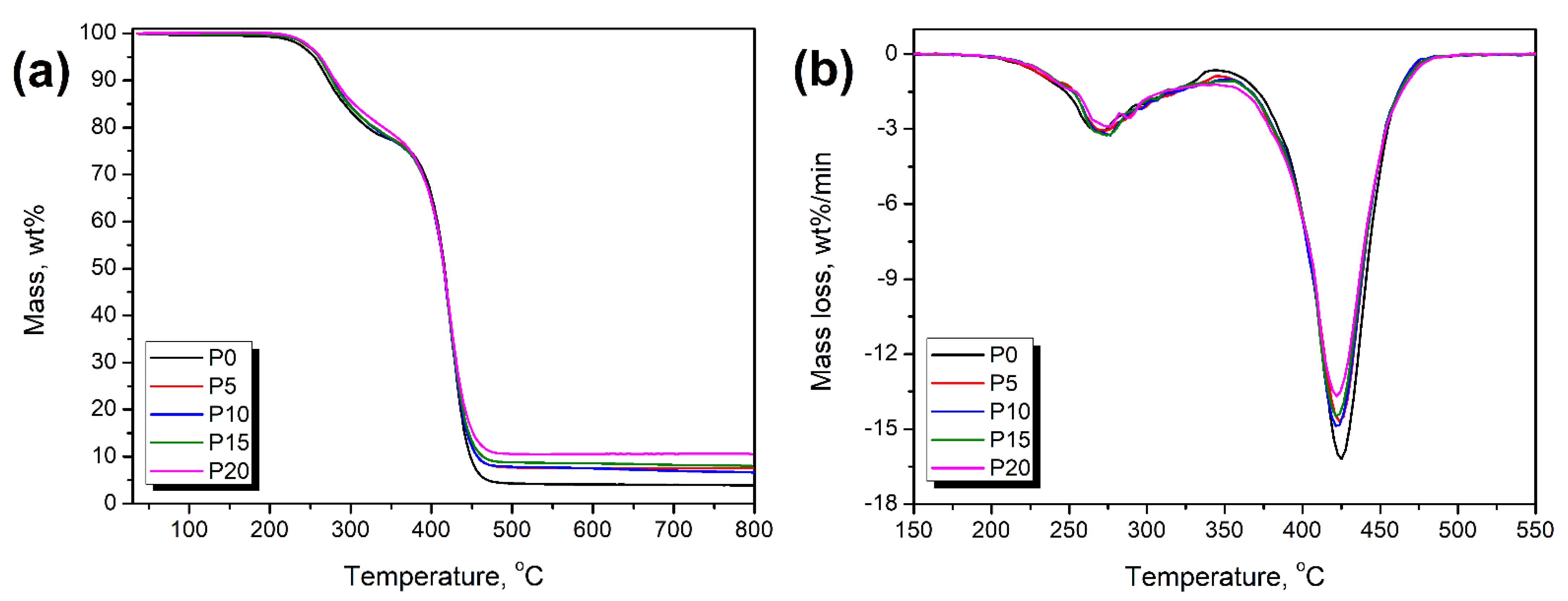
| Material | Producer | Properties/Additional Information |
|---|---|---|
| PTMG 2000 | DuPont (Wilmington, NC, USA) | Poly(tetramethylene ether)glycol, hydroxyl value—56 mg KOH/g, molar mass—2000 g/mol |
| Glycerol | Sigma Aldrich (Poznań, Poland) | Hydroxyl value—1800 mg KOH/g |
| Toluene diisocyanate (TDI) | Sigma Aldrich (Poznań, Poland) | Mixture of 2,4-TDI and 2,6-TDI in the 80/20 ratio |
| Dabco33LV | Air Products (Allentown, PA, USA) | Catalyst, 33 wt% solution of 1,4-diazabicyclo[2.2.2]octane in dipropylene glycol |
| Dibutyltin dilaurate (DBTL) | Sigma Aldrich (Poznań, Poland) | Organic tin catalyst |
| Tegostab B8460 | Evonik Industries AG (Essen, Germany) | Foam stabilizer, polyether polydimethylsiloxane copolymer |
| Distilled water | - | Chemical blowing agent |
| Ground tire rubber | Grupa Recykl S.A. (Śrem, Poland) | Average particle size—0.6 mm |
| Component | Foam Symbol | |||||
|---|---|---|---|---|---|---|
| P0 | P5 | P10 | P15 | P20 | ||
| Content, pbw | ||||||
| 1st step | PTMG | 27.03 | ||||
| TDI | 30.09 | |||||
| Total prepolymer | 57.12 | |||||
| 2nd step | PTMG | 36.80 | ||||
| Glycerol | 5.11 | |||||
| 33LV | 0.31 | |||||
| DBTL | 0.27 | |||||
| B8460 | 0.20 | |||||
| Water | 0.20 | |||||
| GTR | 0 | 5 | 10 | 15 | 20 | |
| Sample | Color Parameters | Digital Color Reproduction | Foam Skin Image | Foam Core Image | |||||
|---|---|---|---|---|---|---|---|---|---|
| L* | a* | b* | ΔE | Chroma | Hue | ||||
| P0 | 86.25 | −0.27 | 3.46 | 0.00 | 3.47 | −85.54 | 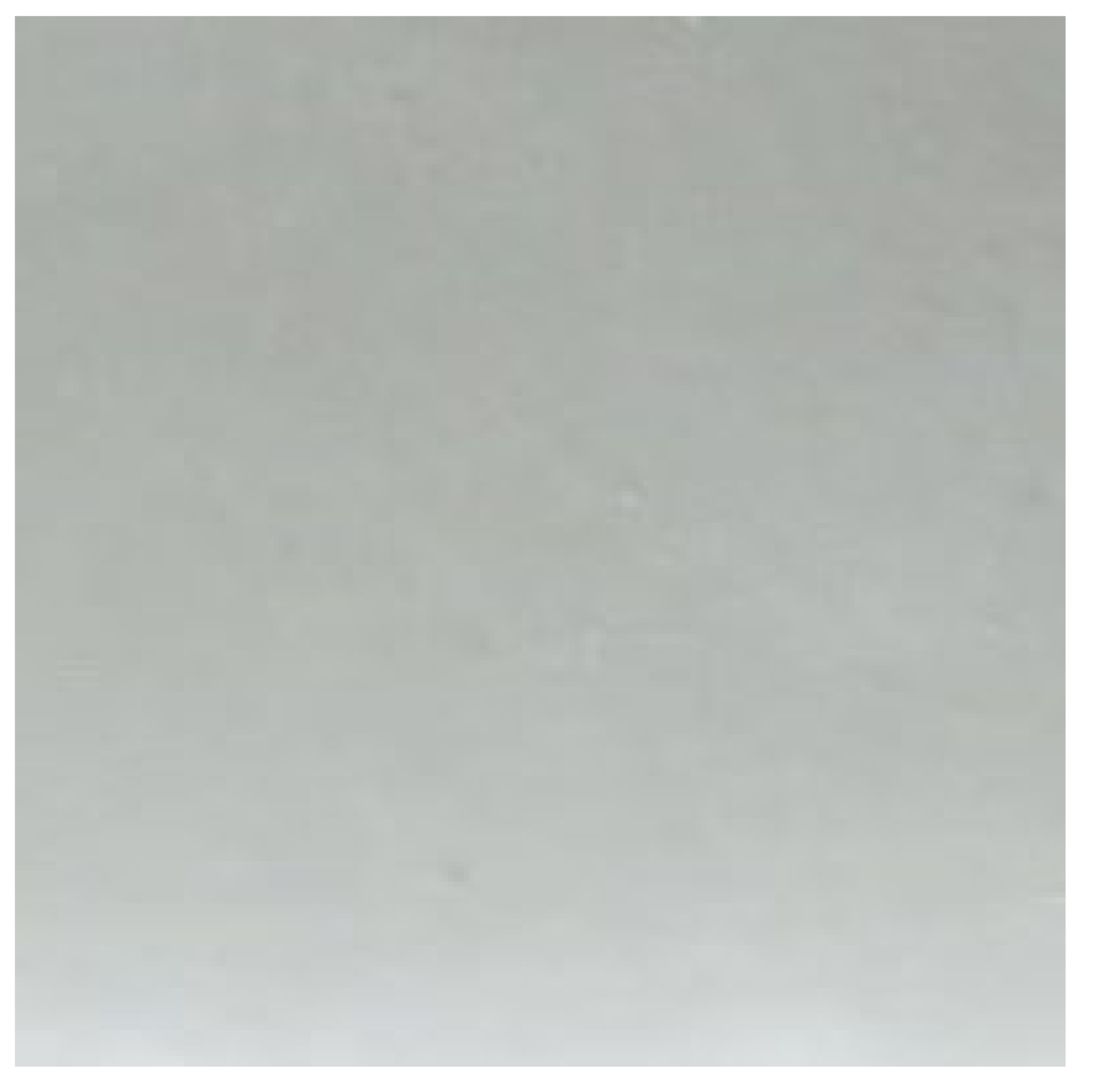 |  | |
| P5 | 69.80 | −0.08 | 2.71 | 16.47 | 2.71 | −88.31 |  |  | |
| P10 | 65.40 | −0.39 | 3.36 | 20.85 | 3.38 | −83.38 |  |  | |
| P15 | 61.97 | −0.51 | 3.33 | 24.28 | 3.37 | −81.29 |  |  | |
| P20 | 58.47 | 0.08 | 5.41 | 27.85 | 5.41 | 89.15 |  |  | |
| Parameter | P0 | P5 | P10 | P15 | P20 |
|---|---|---|---|---|---|
| Average cell diameter, µm | 263.1 ± 64.9 | 188.5 ± 49.7 | 144.8 ± 87.8 | 170.2 ± 78.6 | 178.3 ± 109.0 |
| Circularity | 0.48 ± 0.06 | 0.45 ± 0.17 | 0.43 ± 0.22 | 0.39 ± 0.21 | 0.35 ± 0.20 |
| Aspect ratio | 1.32 ± 0.28 | 1.35 ± 0.30 | 1.38 ± 0.44 | 1.42 ± 0.44 | 1.48 ± 0.41 |
| Roundness | 0.79 ± 0.14 | 0.77 ± 0.14 | 0.78 ± 0.17 | 0.75 ± 0.17 | 0.72 ± 0.16 |
| Open cell content, % | 49.00 ± 2.53 | 53.23 ± 1.97 | 49.09 ± 2.11 | 50.14 ± 2.01 | 51.92 ± 2.66 |
| Apparent density, kg/m3 | 311.8 ± 4.3 | 297.0 ± 1.4 | 309.5 ± 1.9 | 313.0 ± 7.2 | 322.9 ± 3.4 |
| Sol fraction content, wt% | 1.35 ± 0.02 | 1.91 ± 0.08 | 2.18 ± 0.32 | 2.35 ± 0.30 | 2.74 ± 0.21 |
| Thermal conductivity coefficient, mW/(m·K) | 62.90 ± 1.89 | 61.22 ± 1.84 | 62.23 ± 1.56 | 62.27 ± 1.71 | 60.20 ± 1.51 |
Publisher’s Note: MDPI stays neutral with regard to jurisdictional claims in published maps and institutional affiliations. |
© 2022 by the authors. Licensee MDPI, Basel, Switzerland. This article is an open access article distributed under the terms and conditions of the Creative Commons Attribution (CC BY) license (https://creativecommons.org/licenses/by/4.0/).
Share and Cite
Żukowska, W.; Kosmela, P.; Wojtasz, P.; Szczepański, M.; Piasecki, A.; Barczewski, R.; Barczewski, M.; Hejna, A. Comprehensive Enhancement of Prepolymer-Based Flexible Polyurethane Foams’ Performance by Introduction of Cost-Effective Waste-Based Ground Tire Rubber Particles. Materials 2022, 15, 5728. https://doi.org/10.3390/ma15165728
Żukowska W, Kosmela P, Wojtasz P, Szczepański M, Piasecki A, Barczewski R, Barczewski M, Hejna A. Comprehensive Enhancement of Prepolymer-Based Flexible Polyurethane Foams’ Performance by Introduction of Cost-Effective Waste-Based Ground Tire Rubber Particles. Materials. 2022; 15(16):5728. https://doi.org/10.3390/ma15165728
Chicago/Turabian StyleŻukowska, Wiktoria, Paulina Kosmela, Paweł Wojtasz, Mariusz Szczepański, Adam Piasecki, Roman Barczewski, Mateusz Barczewski, and Aleksander Hejna. 2022. "Comprehensive Enhancement of Prepolymer-Based Flexible Polyurethane Foams’ Performance by Introduction of Cost-Effective Waste-Based Ground Tire Rubber Particles" Materials 15, no. 16: 5728. https://doi.org/10.3390/ma15165728






